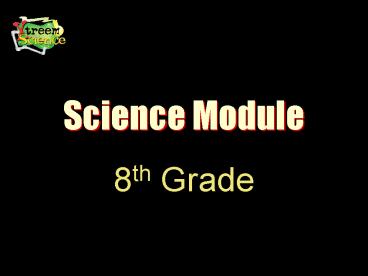Science Module - PowerPoint PPT Presentation
1 / 27
Title:
Science Module
Description:
identify endothermic and exothermic reactions associated with chemical changes ... An example of an exothermic reaction is the mixture of sodium metal and chlorine ... – PowerPoint PPT presentation
Number of Views:148
Avg rating:3.0/5.0
Title: Science Module
1
Science Module
- 8th Grade
2
HOT STUFF
3
- TAKS Objective 3 The student will demonstrate
an understanding of the structures and properties
of matter. - Complex interactions occur between matter and
energy.
4
TEKS 8.10 (C)
- The student knows that complex interactions occur
between matter and energy. The student is
expected to
identify and demonstrate that loss or gain of
heat energy occurs during exothermic and
endothermic chemical reactions.
5
Learning Objectives
- identify endothermic and exothermic reactions
associated with chemical changes - Explain the loss or gain of heat during chemical
reactions - Identify chemical and physical changes associated
with endothermic and exothermic reactions
6
Background
- Heat- transfer of energy
7
- Exothermic- heat energy EXITS the system
- - ex. Combustion, evaporation of water
- - surroundings usually feel warmer
8
Salt
- An example of an exothermic reaction is the
mixture of sodium metal and chlorine gas which
yields table salt. - 2Na(s) Cl2(g) ? 2NaCl(s) energy
9
- Endothermic- heat energy ENTERS the system
- - ex. Cold packs, melting ice
- - surroundings usually feel cooler
10
How do cold packs work?
- The outer pouch contains water. The inner pouch
contains ammonium-nitrate. - When you pop the inner pouch, the chemical
reaction absorbs heat energy from the
surroundings. This is an endothermic reaction. - The temperature of the solution falls to about 35
F for 10 to 15 minutes.
11
Photosynthesis
- During photosynthesis, plants absorb the energy
from the sun to convert carbon dioxide and water
into glucose and oxygen. - sunlight 6CO2(g) 6H2O(l) ? C6H12O6(aq)
6O2(g)
12
- Physical change- change in size, shape or state
of matter
13
- Chemical Reaction - process in which one or more
substances are changed into others. Chemical
reactions are accompanied by a loss or gain of
energy.
14
- True or False
- Chemical reactions always produce heat
15
- Chemical reactions can release or
- absorb heat, but can also create
- light, sound or electricity!
16
- True or False
- Heat can be lost, destroyed
- or just disappear
17
- Heat energy is transferred from one object to
another, or is transferred to another form of
energy, but never disappears. - Law of Conservation of Energy
18
- True or False
- Color change is always a physical property
19
- Color is a physical property.
- Color change can be the result
- of a chemical change.
20
ENGAGE
- Cold Packs
- Rubber Bands
- Glo-sticks
21
EXPLORE
- Hot or Not
- students explore endothermic and exothermic
chemical reactions using baking soda and calcium
chloride
22
EXPLAIN
- List 3 physical properties of matter.
- List 3 physical properties for
- Calcium chloride
- Baking soda
- Phenol red solution
23
- Describe what happens with baking soda and
calcium chloride are mixed. - Describe what happens with baking soda, calcium
chloride and phenol red are mixed. - What are evidences of chemical change?
24
- Is this an endothermic or exothermic reaction?
How do you know? - Give three examples of exothermic reactions in
everyday life.
25
ELABORATE
- Ice Ice Baby
- Baking soda and vinegar
- Is this endothermic or exothermic? How do you
know? - Give 3 examples of everyday endothermic
reactions.
26
- Ice Cream
- Are the changes physical or chemical?
- Is the ice cream endothermic or exothermic? How
do you know? - Is the ice/salt mix endothermic or exothermic?
How do you know?
27
EVALUATION
- Complete Type of Change? Endo/Exo chart
- Complete graph analysis questions































